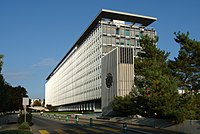
Photo from wikipedia
Manufacturers, such as producers of cigarettes, drugs or ultra-processed foods, influence health policy, research and practice. This influence is one of the main barriers against the implementation of public health… Click to show full abstract
Manufacturers, such as producers of cigarettes, drugs or ultra-processed foods, influence health policy, research and practice. This influence is one of the main barriers against the implementation of public health policies around the world. Our goal was to identify existing mechanisms to limit this influence. We conducted a scoping review in 2019. We searched five scientific databases: Web of Science Core Collection; BIOSIS; MEDLINE; Base; Scopus. Twenty-eight institutions and networks related to our research objective were also contacted to identify additional mechanisms and examples. In addition, we identified mechanisms and examples drawn from our collective experience. We have classified the mechanisms into two groups: those of international organizations and governments; those for universities, the media and civil society. Thirty-one publications were included in our review, including eight scientific articles. Nine mechanisms focused on several industries; while the other documents targeted specific industries. We identified 49 mechanisms that could help limit corporate influence in health policy, science and practice. For 41 of these mechanisms, we found examples, around the world, where they have been implemented. The main objectives of the mechanisms identified were to manage conflicts of interest and ethical issues, while increasing the transparency of public-private interactions. Mechanisms for governments (n = 17) and universities (n = 13) were most frequently identified, with fewer examples existing to protect the media and civil society. The development, implementation and monitoring of these mechanisms are essential to protect public health from industrial influence. We found 49 mechanisms that could help limit corporate influence in health policy, science and practice. There are fewer mechanisms to protect the media and civil society, than to protect governments and universities.
Journal Title: European Journal of Public Health
Year Published: 2021
Link to full text (if available)
Share on Social Media: Sign Up to like & get
recommendations!